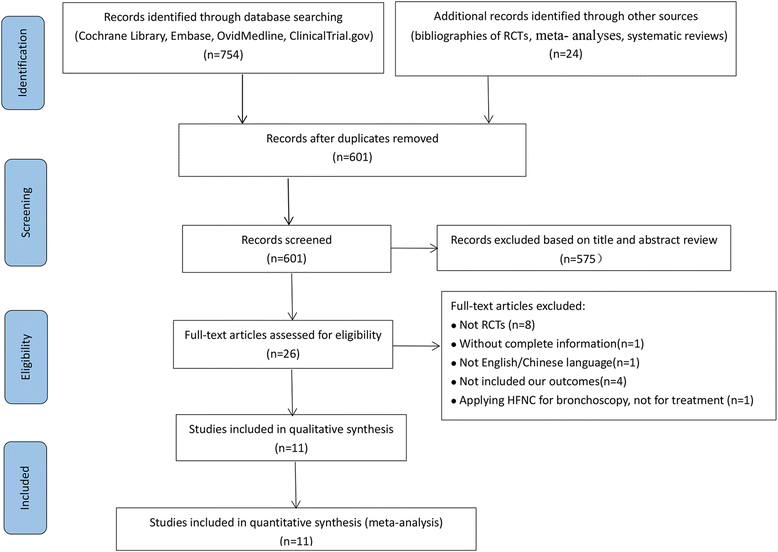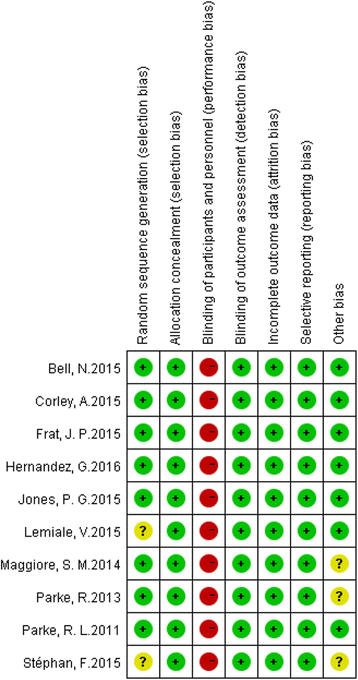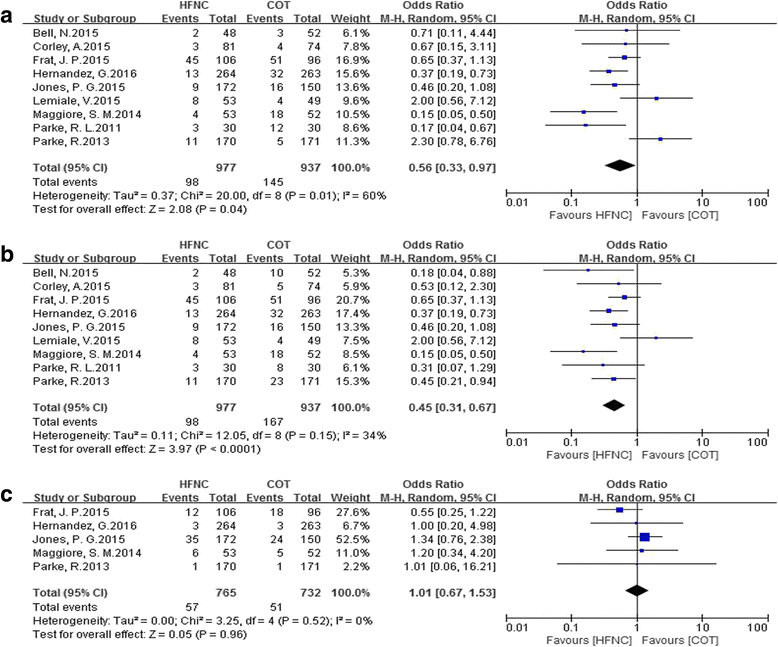High-flow nasal cannula oxygen therapy is superior to conventional oxygen therapy but not to noninvasive mechanical ventilation on intubation rate: a systematic review and meta-analysis
- PMID: 28701227
- PMCID: PMC5508784
- DOI: 10.1186/s13054-017-1760-8
High-flow nasal cannula oxygen therapy is superior to conventional oxygen therapy but not to noninvasive mechanical ventilation on intubation rate: a systematic review and meta-analysis
Abstract
Background: High-flow nasal cannula oxygen (HFNC) is a relatively new therapy used in adults with respiratory failure. Whether it is superior to conventional oxygen therapy (COT) or to noninvasive mechanical ventilation (NIV) remains unclear. The aim of the present study was to investigate whether HFNC was superior to either COT or NIV in adult acute respiratory failure patients.
Methods: A review of the literature was conducted from the electronic databases from inception up to 20 October 2016. Only randomized clinical trials comparing HFNC with COT or HFNC with NIV were included. The intubation rate was the primary outcome; secondary outcomes included the mechanical ventilation rate, the rate of escalation of respiratory support and mortality.
Results: Eleven studies that enrolled 3459 patients (HFNC, n = 1681) were included. There were eight studies comparing HFNC with COT, two comparing HFNC with NIV, and one comparing all three. HFNC was associated with a significant reduction in intubation rate (OR 0.52, 95% CI 0.34 to 0.79, P = 0.002), mechanical ventilation rate (OR 0.56, 95% CI 0.33 to 0.97, P = 0.04) and the rate of escalation of respiratory support (OR 0.45, 95% CI 0.31 to 0.67, P < 0.0001) when compared to COT. There was no difference in mortality between HFNC and COT utilization (OR 1.01, 95% CI 0.67 to 1.53, P = 0.96). When HFNC was compared to NIV, there was no difference in the intubation rate (OR 0.96; 95% CI 0.66 to 1.39, P = 0.84), the rate of escalation of respiratory support (OR 1.00, 95% CI 0.77 to 1.28, P = 0.97) or mortality (OR 0.85, 95% CI 0.43 to 1.68, P = 0.65).
Conclusions: Compared to COT, HFNC reduced the rate of intubation, mechanical ventilation and the escalation of respiratory support. When compared to NIV, HFNC showed no better outcomes. Large-scale randomized controlled trials are necessary to prove our findings.
Trial registration: PROSPERO International prospective register of systematic reviews on May 25, 2016 registration no. CRD42016039581 .
Keywords: Conventional oxygen therapy (COT); High-flow nasal cannula oxygen (HFNC); Intubation; Mortality; Noninvasive mechanical ventilation (NIV).
Conflict of interest statement
Consent for publication
Not applicable.
Competing interests
The authors declare that they have no competing interests.
Publisher’s Note
Springer Nature remains neutral with regard to jurisdictional claims in published maps and institutional affiliations.
Figures







Comment in
-
High-flow nasal cannula versus noninvasive positive pressure ventilation in acute respiratory failure: interaction between PaO2/FiO2 and tidal volume.Crit Care. 2017 Nov 22;21(1):285. doi: 10.1186/s13054-017-1861-4. Crit Care. 2017. PMID: 29166943 Free PMC article. No abstract available.
References
-
- Hayami H, Mizutani K, Shioda M, Takaki S, Maejima H, et al. Use of high-flow nasal canulae: effect on alveolar pressure and its limitation. Crit Care. 2013;17(Suppl 2):91. doi: 10.1186/cc12029. - DOI
Publication types
MeSH terms
Substances
LinkOut - more resources
Full Text Sources
Other Literature Sources
Medical
Miscellaneous

